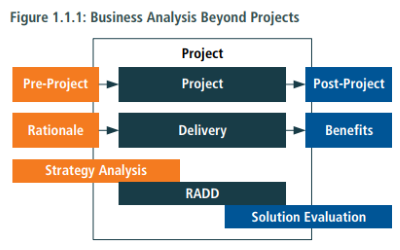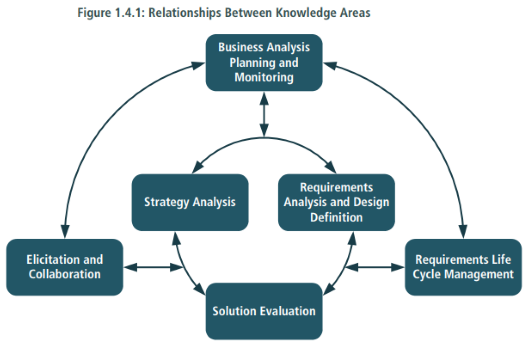Introduction of BABOK 3
Table of contents :
Chapter 1. Introdution
- Purpose of the BABOK Guide - 1
- What is Business Analysis? - 2
- Who is a Business Analyst? - 2
- Structure of the BABOK Guide - 3
Chapter 2. Business Analysis Key Concepts
- The Business Analysis Core Concept Module - 12
- Key Terms - 14
- Requirements Classification Schema - 16
- Stakeholders - 16
- Requirements and Designs - 19
Chapter 3. Business Analysis Planning and Monitoring
- Plan Bunisess Analysis Approach - 24
- Plan Stakeholder Engagement - 31
- Plan Business Analysis Governance - 37
- Plan Business Analysis Information Management - 42
- Identify Business Analysis Performance Improvements - 47
Chapter 4. Elicitation and Collaboration
- Prepare for Elicitation - 56
- Conduct Elicitation - 61
- Confirm Elicitation Result - 65
- Communicate Business Analysis Information - 67
- Manage Stackeholder Collaboration - 71
Chapter 5. Requirements Life Cycle Management
- Trace Requirements - 79
- Maintain Requirements - 83
- Prioritize Requirements - 86
- Assess Requirements Changes - 91
- Approve Requirements - 95
Chapter 6. Strategy Analysis
- Analyze Current State - 103
- Define Future State - 110
- Assess Risks - 120
- Define Change Strategy - 124
Chapter 7. Requirements Analysis and Design Definition
- Specify and Model Requirements - 136
- Verify Requirements - 141
- Validate Requirements - 144
- Define Requirements Architecture - 148
- Define Design Options - 152
- Analyze Potential Value and Recommend Solution -157
Chapter 8. Solution Evaluation
- Measure Solution Performance - 166
- Analyze Performance Measures - 170
- Asses Solution Limitations - 173
- Assess Enterprise Limitations - 177
- Recommend Actions to Increase Solution Value - 182
Chapter 9. Underlying Competencies
- Analytical Thinking and Problem Solving - 188
- Behavioural Characteristics - 194
- Business Knowledge - 199
- Communication Skills - 203
- Interaction Skills - 207
- Tools and Technology - 211
Chapter 10. Techniques
- Acceptance and Evaluation Criteria - 217
- Backlog Management - 220
- Balanced Scorecard - 223
- Benchmarking and Market Analysis - 226
- Brainstorm - 227
- Business Capability Analysis - 230
- Business Case - 234
- Business Model Canvas - 236
- Business Rules Analysis - 240
- Collaborative Games - 243
- Concept Modeling - 245
- Data Dictionary - 247
- Data Flow Diagrams - 250
- Data Mining - 253
- Data Modeling - 256
- Decision Analysis - 261
- Decision Modeling - 265
- Document Analysis - 269
- Estimation - 271
- Financial Analysis - 274
- Focus Group - 279
- Functional Decomposition - 283
- Grossary - 286
- Interface Analysis - 287
- Interviews - 290
- Item Tracking - 294
- Lessons Learned - 296
- Metric and Key Performance Indicatiors (KPIs) - 297
- Mind Mapping - 299
- Non-functional Requirements Analysis - 302
- Observation - 305
- Organization Moduling - 308
- Prioritization - 311
- Process Analysis - 314
- Process Moduling - 318
- Prototyping - 323
- Reviews - 326
- Risk Analysis and Management - 329
- Roles and Permission Matrix - 333
- Root Cause Analysis - 335
- Scope Moduling - 338
- Sequence Diagrams - 341
- Stakehoder List, Map, or Personas - 344
- StateModeling - 348
- Survey or Questionnarie - 350
- SWOT Analysis - 353
- Use Case and Scenarios - 356
- User Stories - 359
- Vendor Assessment - 361
- Workshops - 363
Chapter 11. Perspectives
- The Agile Perspective - 368
- The Business Intelligence Perspective - 381
- The Information Technology Perspective - 394
- The Business Architecture Perspective - 408
- The Business Process Management Perspective - 424
Appendix A: Grossary - 441
Appendix B: Techniques to Task Mapping - 457
Appendix C: Contributer - 473
Appendix D: Summar of Changes from BABOK Guide v2 - 483
Chapter 1. INTRODUCTION
1. Purpose of the BABOK Guide
The primary purpose of the BABOK Guide is to define the profession of business analysis and provide a set of commonly accepted practices.
Practitioners may employ different compentencies, knowledge, skills, terminology, and attitudes that they use when performing business analysis tasks.
The six knowledge area of the BABOK Guide (Business Analysis Planning and Monitoring, Elicitation and Collaboration, Requirements Life Cycle Management, Strategy Analysis, Requirements Analysis and Design Definition (RADD), and Solution Evaluation) decribe the practice of business analysis as it is applied within the boundaries of a project or throughout enterprise evolution and continous improvement.

2. What is Business Analysis?
Business analysis is the practice of enabling change in an enterprise by defining needs and recommending solutions that deliver value to stakeholder.
3. Who is a Business Analysis
A business analyst is any person who perform business analysis tasks described in the BABOK Guie, no matter their job title or organizational role. Business analysts are responsible for discovering, synthesizing, and analyzing information from a variety of sources within an enterprise, including tools, processes, documentation, and stakeholders. The BA is responsible for eliciting the actual needs of stakeholders - which frequently involves investigating and clarifying their expressed desires - in order to determine underlying issues and causes.
Business analysts play a role in aligning the designed and delivered solutions with the needs of stakeholders. The activities that business analysts perform include:
- understanding enterprise problem and goals,
- analyzing needs and solutions,
- devising change, and
- facilitating stakeholder collaboration.
Other common job titles for people who perform business analysis include:
- business architect,
- business systems analyst,
- data analyst,
- enterprise analyst,
- management consultant,
- process analyst,
- product manager,
- product owner,
- requirements engineer, and
- systems analyst.
4. Stucture of the BABOK Guide
- Business Analysis Key Concepts: define the key trems needed to understand all other content, concepts, and ideas within the BABOK Guide.
- Underlying Competencies: provide a descripton of the behaviours, characteristics, knowlegde, and personal qualities that supportsthe effective practice of business analysis.
- Techniques: provide a means to perform business analysis tasks. The techniques described in the BABOK Guide are intended to cover the most common and widespread techniques practiced within the business analysis community.
- Perspectives: describe various views of business analysis. Perspectives help business analysts working from various points to view to better perform business analysis taks, given the context of the initiative.
a. Key Concepts
b. Knowlegde Areas
- Business Analysis Planning and Monitoring
- Elicitation and Collaboration
- Requirements Life Cycle Management
- Strategy Analysis
- Requirements Analysis and Design Definition
- Solution Evalueation

Each Task in the BABOK Guide is presented in the following format:
- Purpose
- Description
- Inputs
- Elements
- Guidelines / Tools
- Techniques
- Stackeholders
- Outputs
c. Underlying Competencies
- Purpose
- Definition
- Effectiveness Measures
d. Techniques
- Purpose
- Description
- Elements
- Usage Considerations
e. Perspectives
*** The perspectives included in BABOK Guide are:
- Agile
- Business Intelligence
- Information Technology
- Business Architecture
- Business Process Management
*** Perspectives have the following structure:
- Change Scope
- Business Analysis Scope
- Methodologies, Approachs, and Techinques
- Underlying Competencies
- Impact on Knowlegde Areas